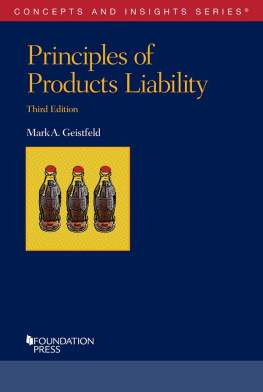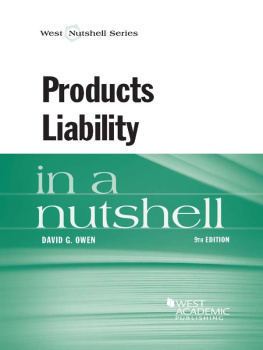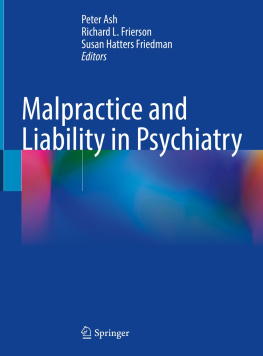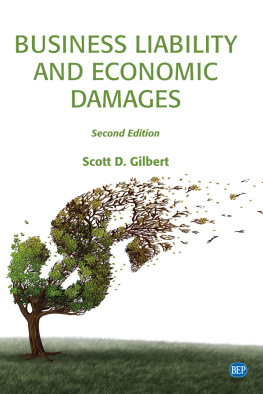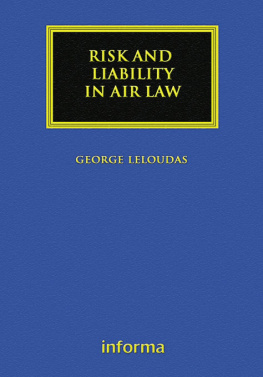Editorial Board
Saul Levmore
Directing Editor
William B. Graham Distinguished Service Professor of Law and
Former Dean of the Law School
University of Chicago
Daniel A. Farber
Sho Sato Professor of Law
University of California at Berkeley
Heather K. Gerken
Dean and the Sol & Lillian Goldman Professor of Law
Yale University
Samuel Issacharoff
Bonnie and Richard Reiss Professor of Constitutional Law
New York University
Harold Hongju Koh
Sterling Professor of International Law and
Former Dean of the Law School
Yale University
Thomas W. Merrill
Charles Evans Hughes Professor of Law
Columbia University
Robert L. Rabin
Calder Mackay Professor of Law
Stanford University
Hillary A. Sale
Professor of Law and Affiliated Faculty
McDonough School of Business, Georgetown University
Principles of Products Liability
Third Edition
Mark A. Geistfeld
Sheila Lubetsky Birnbaum Professor of Civil Litigation
New York University School of Law
CONCEPTS AND INSIGHTS SERIES

The publisher is not engaged in rendering legal or other professional advice, and this publication is not a substitute for the advice of an attorney. If you require legal or other expert advice, you should seek the services of a competent attorney or other professional.
Concepts and Insights Series is a trademark registered in the U.S. Patent and Trademark Office.
2006 FOUNDATION PRESS
2011 By THOMSON REUTERS/FOUNDATION PRESS
2020 LEG, Inc. d/b/a West Academic
444 Cedar Street, Suite 700
St. Paul, MN 55101
1-877-888-1330
Printed in the United States of America
ISBN: 978-1-64242-582-6
For Janette and Max
Acknowledgments
In the course of learning tort law, Ive accumulated way too many debts of gratitude to acknowledge properly here. My previously published work has enormously benefitted from the input of colleagues, and much of that work has been incorporated into this book. The most useful feedback has come from my students at NYU, in both Torts and Products Liability classes, who over the years have helped me to develop many of the ideas in this book. Any improvements in the exposition of this edition owe a great deal to the teaching experiences Ive had with the two prior editions. Financial support was provided by the Filomen DAgostino and Max E. Greenberg Research Fund of the New York University School of Law.
As in the past, this edition relies on some of my recently published work in ways that Ive tried to convey in the footnotes, though it is hard to adequately do so. This edition is also complementary to, but independent of, my casebook Products Liability Law (2d ed. forthcoming 2022).
My most deeply felt thanks go to Janette Sadik-Khan and our son Max for their encouragement and support.
Mark A. Geistfeld
New York City
February 2020
A Note on Citations
Unlike the traditional law review article or legal brief, I have not provided citations for every legal proposition. Aside from the citations for direct quotations, I have tried to give those citations that provide a good entry into the extensive literature on products liability and related issues in tort law. Many citations are repeated throughout the book, and for those I have used the following abbreviations:
Dobbs Law of Torts
Dan B. Dobbs, Paul T. Hayden & Ellen M. Bublick, The Law of Torts (2d ed. 2019 update)
Owen & Davis on Products Liability
David G. Owen & Mary J. Davis, Owen & Davis on Products Liability (4th ed. 2014 and 2019 update)
Owen, Products Liability Law
David G. Owen, Products Liability Law (3d. ed. 2015)
Prosser & Keeton on Torts
W. Page Keeton, Dan B. Dobbs, Robert E. Keeton, and David G. Owen, Prosser and Keeton on the Law of Torts (5th ed. 1984)
Restatement (Second)
Restatement (Second) of Torts 1503 (Am. L. Inst. 1965)
Restatement (Second) of Torts 504A707A (Am. L. Inst. 1977)
Restatement (Second) of Torts 708end (Am. L. Inst. 1979)
Restatement (Third)
Restatement (Third) of Torts: Products Liability (Am. L. Inst. 1998)
Shapo on the Law of Products Liability
Marshall S. Shapo, Shapo on the Law of Products Liability (7th ed. 2017 and 2019 update)
Table of Contents
PART ONE. CONCEPTUAL OVERVIEW
PART TWO. DOCTRINAL ANALYSIS
B. Malfunctions Defined by the Manufacturers
Intentions
Unavoidably Unsafe Product Exemption from
Strict Liability
Chapter 13. Legal or Proximate Cause (a Reprise of
Duty)
B. The Deterrence and Retributive Rationales for
Punitive Damages
Principles of Products Liability
Third Edition
Introduction
Product risk is pervasive, increasingly so in the modern economy. Automobiles can crash. Drugs can have harmful side effects. Chemicals can be carcinogens. Even seemingly benign products pose a risk of serious physical harm. Food, the most basic of all products, can be contaminated. Or a bottle of soda can explode.
The probability that a product will severely injure a particular person is typically quite low. But when millions of people use products, a low probability of individual injury translates into a vast number of product-caused injuries. In 2017, 10.5 million people were treated in emergency departments for injuries resulting from consumer products. Most of the injuries involve everyday products often assumed to be safe.
When a product causes physical harm, a question of tort law arises. Does the victim have a right to receive monetary compensation for the injury from the product seller? The answer is determined by the set of tort rules known as products liability. Like tort law more generally, products liability is a form of civil liability not based on contract that determines whether one party (the commercial distributor of a product) is liable for having caused harm to another (consumers or bystanders injured by the product). The extent to which well-established tort principles justify the rules of products liability, though, is less clear.
The origins of products liability can be traced to the ancient English laws that subjected the sellers of contaminated food to strict liability. In the influential 1944 case Escola v. Coca Cola Bottling Co. , Justice Roger Traynor of the California Supreme Court argued that the contaminated-food cases justify a tort rule making product sellers strictly liable for physical harms caused by defective products. In 1965, this rule of strict products liability was adopted by the American Law Institute in section 402A of the Restatement (Second) of Torts , and then by almost all states within the next ten years. The dozen or so pages devoted to strict products liability in the Restatement (Second) subsequently generated a body of law requiring over 300 pages of exposition in the Restatement (Third) of Torts: Products Liability , which was adopted by the American Law Institute in 1998.
The growth of products liability has been astounding, particularly when compared to the slowly evolving tort rules of the common law. In 2017, for example, manufacturers and other product sellers paid almost $2.7 trillion in net premiums for insurance covering products liability claims.
In light of such rapid liability growth, many do not find it plausible that products liability is based on well-established principles of tort law. According to one view, the growth of products liability can be attributed to a conceptual revolution that is among the most dramatic ever witnessed in the Anglo-American legal system.

